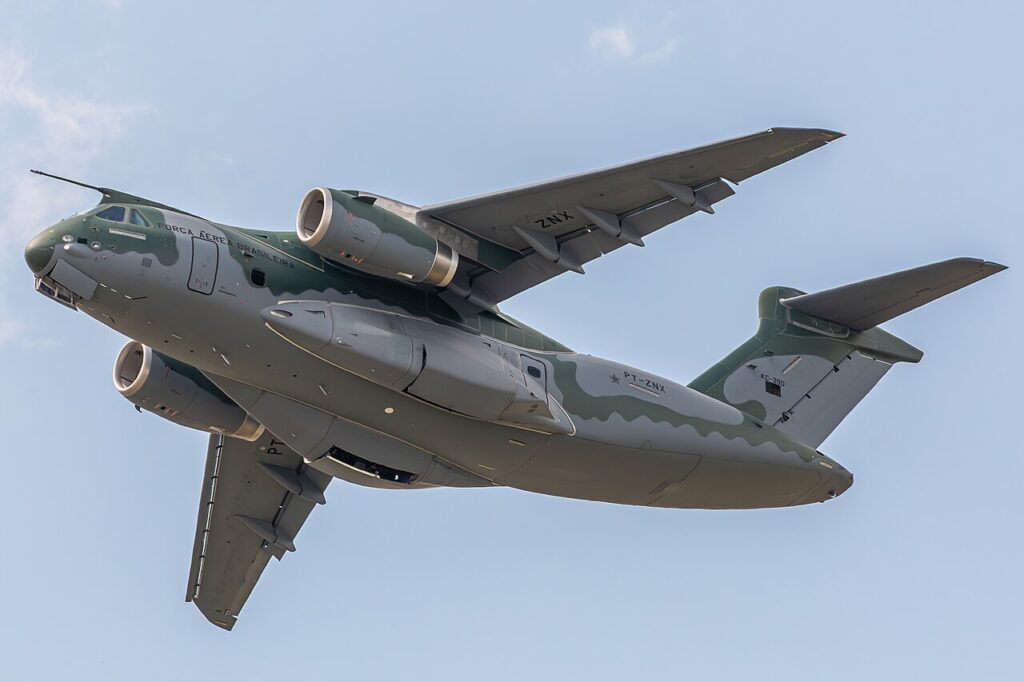
Embraer KC-390 at the Paris Air Show 2019, Le Bourget. Photo by Matti Blume, licensed under CC BY-SA 4.0, via Wikimedia Commons.
When we think about the next big thing in military transport aircraft, the Embraer C-390 Millennium often comes up. Is it truly one of the strongest candidates to take the lead globally, or is it just another ambitious effort that falls short? The Embraer C-390 Millennium, along with its aerial refueling version, the KC-390 (KC means Kerosene Cargo), is a modern, twin-engine, jet-powered aircraft designed and built by Embraer—a company stepping boldly into new territory with this project. These aircraft are the heaviest and most sophisticated platforms Embraer has ever created. They’re built to handle everything from military operations to humanitarian missions, offering a fresh take on what a transport plane can do.
How the C-390 Took Off
The story of the Embraer C-390 begins in the 1990s, sparked by a military transport aircraft need from the Brazilian Air Force (FAB). Serious planning kicked off in the mid-2000s. At first, Embraer considered tweaking its E190 jetliner, but they soon realized that wouldn’t cut it. The FAB had big expectations, so Embraer started from scratch, aiming to craft a jet-powered aircraft that could stand toe-to-toe with—or even outshine—veterans like the Lockheed C-130 Hercules.
Projects like this aren’t easy. They take time, money, and a lot of faith, especially with all the uncertainties involved. Embraer knew this and asked the FAB and Brazilian government for a solid commitment to buy the aircraft—but only if it could deliver performance at least as good as the C-130. Without that promise, the government wasn’t ready to jump in.
While hashing things out, Embraer did some homework. They saw that the C-130 Hercules, a staple since 1954, still ruled the market—but its days were numbered. With hundreds, maybe even thousands, of those planes nearing retirement, there was a wide-open opportunity for something new. Embraer wanted to be the one to step in.
They told the government, “We can build what you’re asking for.” At first, the response was a modest $33 million offer—barely enough to get off the ground, let alone compete with the C-130. After more talks, the Brazilian government came through in a bigger way, pledging R$800 million (about $440 million) in May 2008. The FAB followed up with an order for 22 to 30 C-390s, and in April 2009, a $1.5 billion contract sealed the deal for two prototypes.
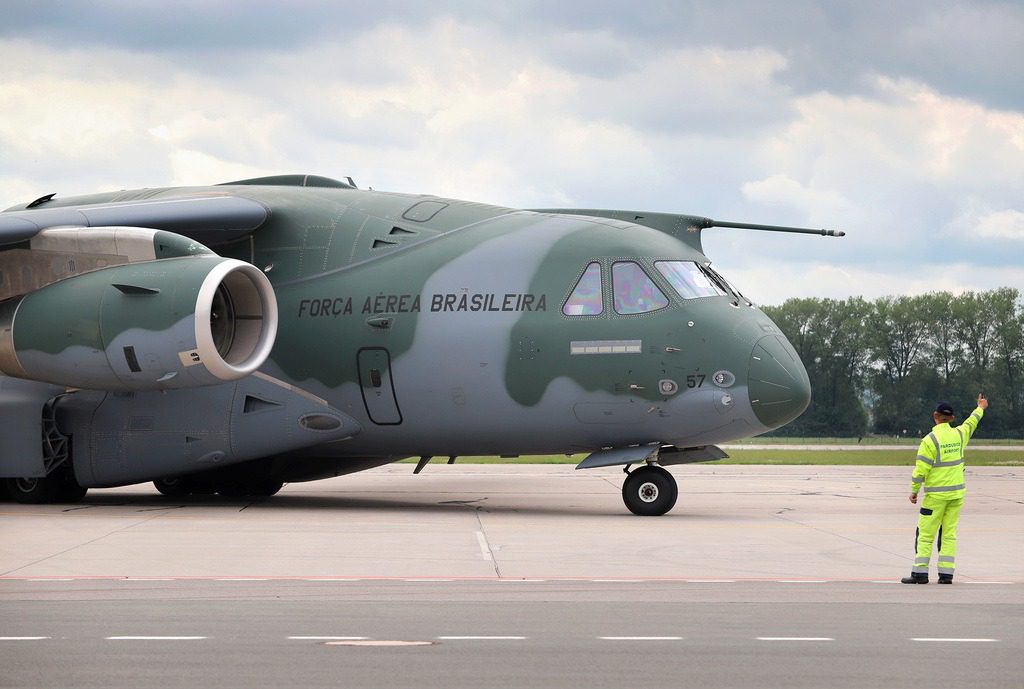
Shaping the Design
The aircraft started as the C-390, but in 2011, it became the KC-390 to spotlight its refueling abilities. By November 2019, Embraer gave it a global name—the C-390 Millennium—while keeping KC-390 for the refueling variant.
One of the toughest choices was the engine. Turboprops or turbofans? Both had their strengths, but Embraer could only pick one. After long discussions, they went with turbofans and placed them high on the aircraft to protect them from rough terrain. Later, they settled on the V2500-E5 turbofan, made by International Aero Engines AG (IAE), a Zürich-based partnership known for reliable engines.
The Embraer C-390/KC-390 also got a boost from smart tech: a fly-by-wire system from BAE Systems for smoother handling and a Rockwell Collins Pro Line Fusion avionics setup that gives pilots clear, real-time info through head-up displays and user-friendly controls. It has a fully integrated Onboard Maintenance System is reducing downtime and cost, enabling the C-390/KC-390 to achieve the higher availability levels, as the commercial aviation.
The C-390/KC-390 is equipped with a Self-Protection System that integrates a wide array of Detection and Declaration devices, including Radar Warning, Laser Warning, and Missile Approach Warning systems, along with effective Countermeasures such as Chaff, Flare, and Directed Infrared Countermeasures (DIRCM), significantly improving the aircraft’s survivability in hostile environments.
In the end, the C-390/KC-390 Millennium is a high-wing aircraft powered by two V2500-E5 turbofans—military-grade versions of a trusted commercial engine. That jet power lets it cruise at 470 knots (870 km/h) and climb to 36,000 feet, leaving turboprop rivals in the dust. It’s not just an idiom because it’s also literal, as the C-390/KC-390 can operate on temporary or unpaved runways like filled soil, gravel and even covered with ice and snow on the
freezing cold Antarctic continent. It’s designed for extreme climates, including hot and sandy desert conditions, so it’s ready for tough spots.
Its cargo bay is thoughtfully designed—18.5 meters long, 3.45 meters wide, and 2.95 meters high (stretching to 3.2 meters at the back). A rear ramp makes loading and unloading a breeze, and it works with standard gear like 463L pallets.
The Embraer KC-390 takes it further with aerial refueling. Without needing major changes, it can refuel planes and helicopters at speeds from 120 to 300 knots(Even Each pod provides fuel transfer up to 400 US GPM) and altitudes between 2,000 and 32,000 feet, using Cobham’s probe-and-drogue pods(Cobham 912-E Series). It can also take on fuel mid-flight to go farther or refuel ground vehicles and bases. By April 2021, it was fully certified for refueling, making it a logistical standout.
Taking Flight
The C-390 first soared on February 3, 2015. It earned civil certification given by the Brazilian Civil Airworthiness authority in accordance with FAA 14 CFR Part 25 standards in October 2018, and the FAB got its first production model on September 4, 2019. By March 2023, it was fully operational.
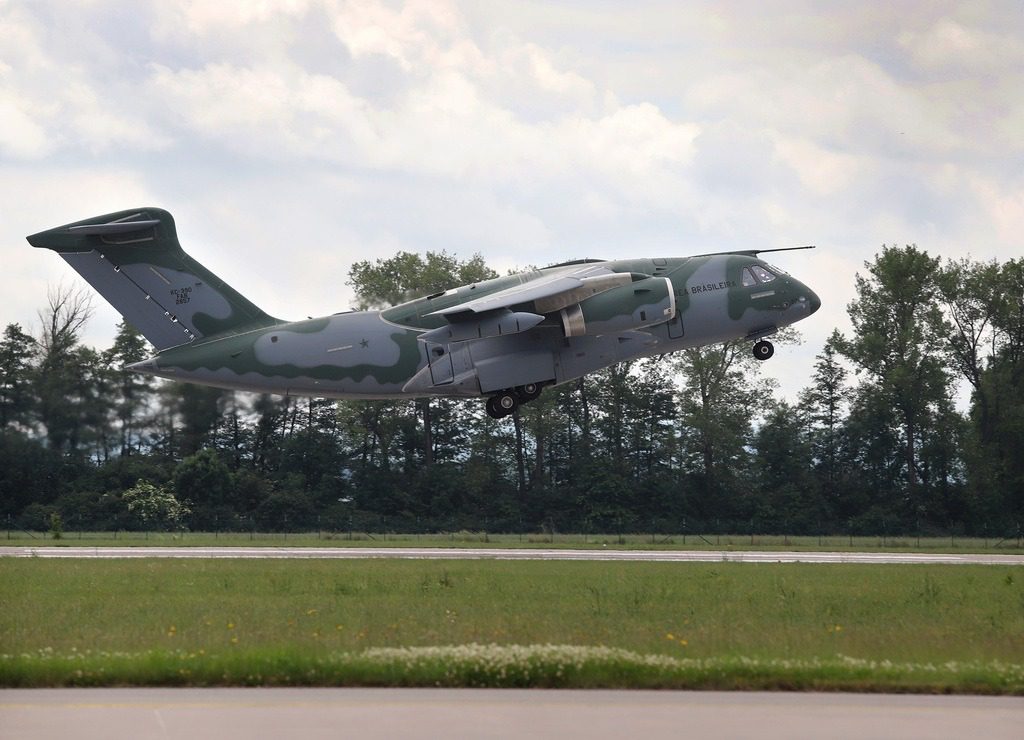
Embraer didn’t do it alone. Partners like Argentina’s FAdeA, Chile’s ENAER, Portugal’s OGMA, and Boeing (until their collaboration ended in 2020) helped along the way. As of now, Embraer has signed new agreements with South Africa’s Denel and Turkey’s TUSAŞ during the LAAD Defense and Security exhibition in Brazil to keep the momentum going.
What Embraer C-390 Can Carry
The C-390/KC-390 is a multi-tasker, able to haul up to 26 tons (57,000 lbs). It can carry:
- Two M113 armored personnel carriers or one Boxer/VBTP-MR Guarani wheeled vehicle.
- A Sikorsky H-60 helicopter.
- Up to 80 soldiers, 66 fully geared paratroopers, or 74 medical litters for evacuations.
- Loads up to 19 tons (42,000 lbs) for airdrops.
- The crew consists of two pilots and one loadmaster.
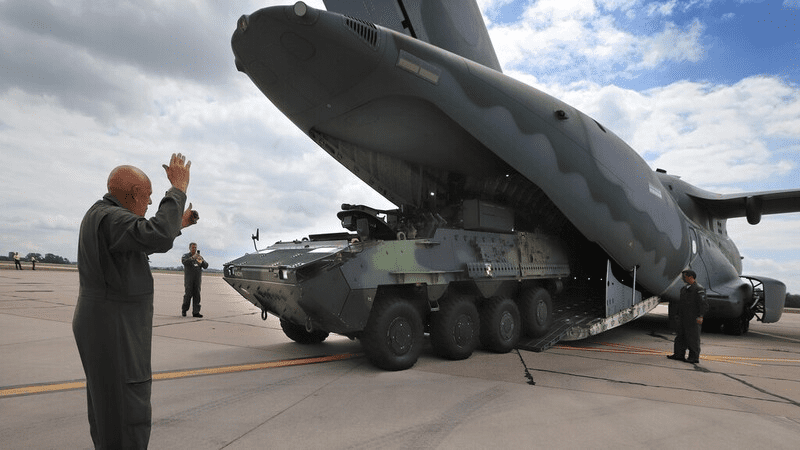
Switching Roles
Embraer says it best: “The C-390 Millennium can be reconfigured for any mission in 3 hours or less.” That flexibility saves time and keeps operations running smoothly.
It’s built for cargo runs, troop drops, search and rescue, high and low speed refueling, firefighting (certified with the MAFFS II system in 2022), precise airdrops, medical evacuations, and disaster relief.
It’s not just about utility and comfort matters too. There’s a galley, an accessible toilet, and features to cut down on noise and vibration for those on board.
By the Numbers
- Range: Up to 3,310 nautical miles (6,130 km) with a 23-ton payload; over 6,000 km(approximately 6.240 km, 3,880 mi, 3,370 nmi) without cargo. If you fly with aux. fuel tanks, the aircraft has 8,460 km (4,570 nmi; 5,260 mi) max. limit.
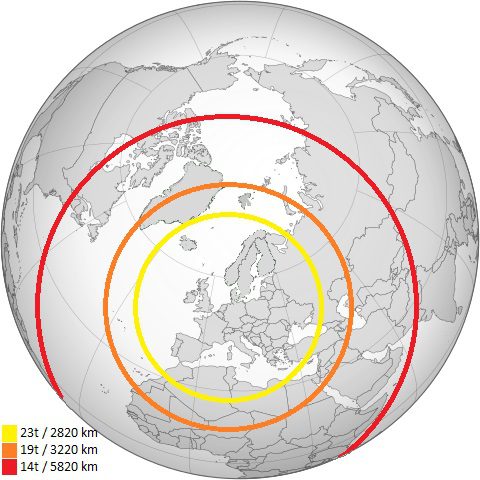
- Speed: Tops out at 520 knots (960 km/h)—much faster than turboprops. Curise speed is 870 km/h (540 mph, 470 kn) Mach 0.8 and stall speed is 193 km/h (120 mph, 104 kn) IAS
- Takeoff/Landing: Needs just 3,000 feet of runway, even fully (86,999 kg (191,800 lb)) loaded.
- Service ceiling: 11,000 m (36,000 ft)
- Cost Efficiency: Embraer says it’s the cheapest to maintain in its class, with an 80% readiness rate in Brazil and less downtime. It needs only 4 man-hours for routine check(every 14 days of operation), 9 to 12 days for intermediate check(600 FH or 12 months), and 25 to 35 days for basic checks(60 months).
- Length: 35.2 m (115 ft 6 in)
- Wingspan: 35.05 m (115 ft 0 in)
- Height: 11.84 m (38 ft 10 in)
- Fuel capacity: 23,000 to 35,000 kg (50,700 to 77,160 lb) with 3 aux. fuel tanks
- Useful lift: 26,000 kg (57,320 lb)
Embraer C-390 In Action
The Brazilian Air Force, the first to sign on, ordered 19 C-390s (down from 28 due to budget limits). As of early 2025, six are flying, with over 9,100 hours logged by mid-2023. It’s already shown its worth:
- Delivering medical supplies during COVID-19.
- Bringing aid after the 2020 Beirut blasts and 2021 Haiti earthquake.
- Resupplying Brazil’s Antarctic base in 2023.
- Training with the U.S. Air Force in 2021.
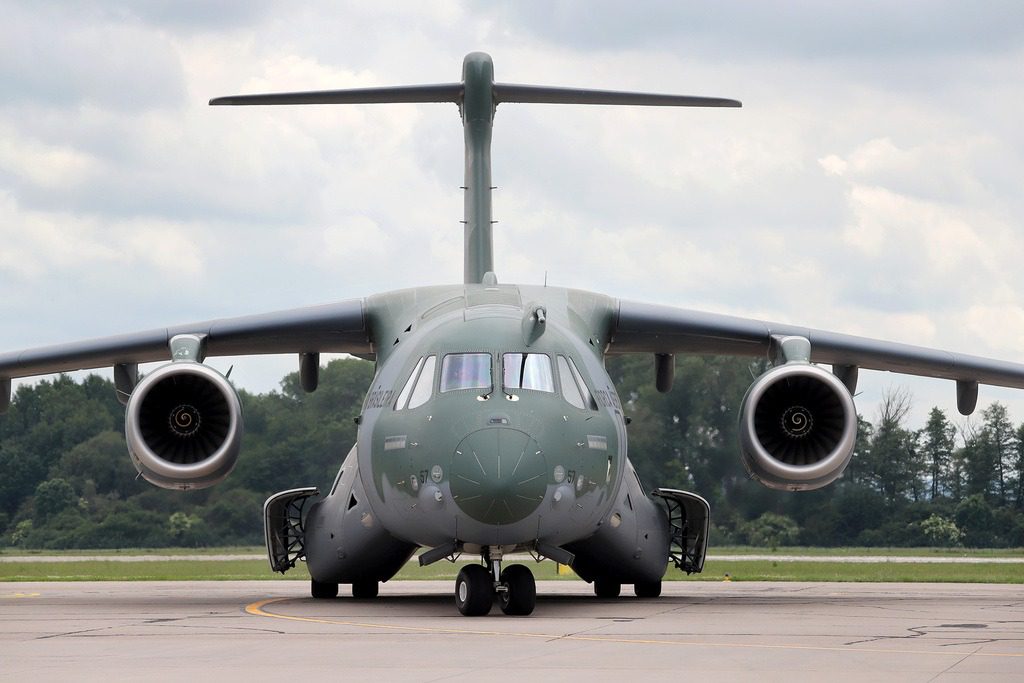
It’s catching on worldwide too:
- Portugal: Ordered five C-390/KC-390s in 2019; the first arrived in 2023, making them the first export buyer.
- Hungary: Ordered two in 2020; the first landed in September 2024 with an ICU onboard.
- Netherlands: Ordered five in 2022; deliveries start in 2026.
- Austria: Ordered four in 2023 to replace C-130Ks.
- Czech Republic: Ordered two in 2023.
- South Korea: Ordered three in December 2023; deliveries by 2026.
- Sweden: Ordered four in 2025, joining a growing European list.
Brazilian Minister of Defense José Múcio announced that Brazil is currently engaged in negotiations with Poland, Finland, and Turkey at the LAAD 2025 conference held in Rio de Janeiro. Other prospective buyers include Colombia, Chile, Egypt, Saudi Arabia, the United Arab Emirates, Greece, Morocco, Uzbekistan, and Rwanda.
How It Stacks Up
The C-390/KC-390 often gets compared to the Lockheed Martin C-130J Super Hercules. The C-130J carries a bit less (19 tons) and runs on turboprops, shining in slow, low-altitude work. The C-390/KC-390’s jets give it better speed and range. Embraer claims it’s 40% more efficient for long hauls. Its newer design also means less time in the shop, a big plus over the older C-130.
Looking Ahead
Embraer’s not stopping here. They’re working with Portugal and Brazil on adding surveillance and reconnaissance features. There’s even talk of a civilian cargo version, using its civil certification and commercial-grade engines like the V2500. Priced around $100 million per unit, with over 40 orders by 2025, the C-390/KC-390 is making a strong case as a future leader in medium-lift transport.
Wrapping Up
The Embraer C-390/KC-390 bring together advanced tech, adaptability, and value, winning over air forces looking to update their transport fleets. With real-world results and a growing list of buyers, they show Embraer’s determination to shake up the military transport world. Could this be the new standard? It’s certainly starting to feel that way.





